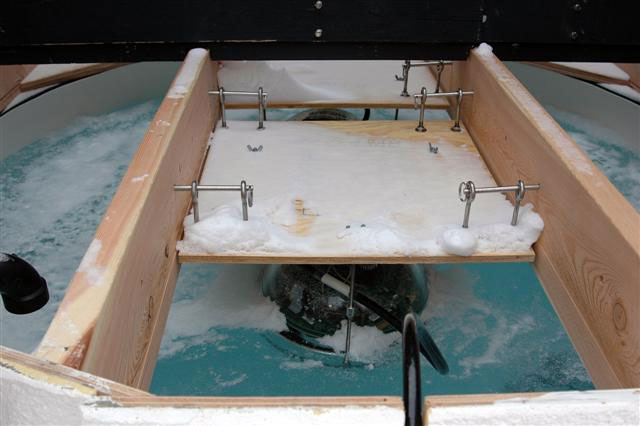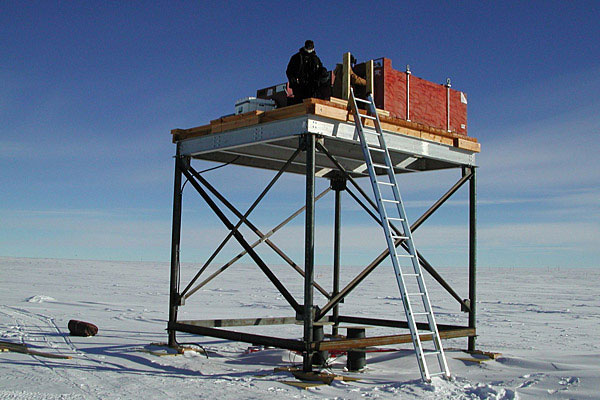Early warning systemNeutron detectors at South Pole offer way to predict damaging radiation from the sunPosted August 10, 2012
One of the most frigid places on the planet appears to be an ideal location to help protect humans living and working in the cold of outer space against radiation bursts from the sun. Scientists recently reported in the journal Space Weather that neutron detectors at the U.S. Antarctic Program’s South Pole Station The high-energy protons and other subatomic particles ejected during such events blast through space near the speed of light. The particles that hit the Earth, called primary cosmic rays, are destroyed when they hit the atmosphere, producing a cascade of secondary subatomic particles. Neutron detectors at the South Pole are particularly sensitive to the highest and rarest of the high-energy particles, which arrive before a slower but more intense “wave” of high-energy particles capable of delivering hazardous doses of radiation to humans in space. The researchers used the measurements from a pair of ground-based detectors at the South Pole to predict the peak intensity at different particle energies. “What we’re predicting is a particle storm, which is a high-energy, high-intensity burst of particle radiation,” explained Paul Evenson The solar storm that produces such a blast of high-energy particles usually arrives about two days later, with the potential to disrupt satellites and the planet’s energy grid. Such an event crashed into Earth’s magnetic field in mid-July, doing no damage but producing some of the most intense auroral displays seen in years, including at the South Pole. These sorts of sun-generated storms are outside the scope of the South Pole early-warning system. The team validated its method against data collected from satellites that are part of the Geostationary Operational Environmental Satellite System (GOES) “The instruments on the spacecraft are just too small to detect the faster, high-energy particles. They are set up to detect the particles that are most damaging,” he explained. While the method presented in the Space Weather paper — “South Pole neutron monitor forecasting of solar proton radiation intensity” — offers an average warning time of 166 minutes, Evenson warned that it’s not foolproof. The Earth has to be in the proper orientation to observe the highest-energy particles, he said. “It’s very effective when it works, but it’s possible an event could slip through without much warning,” he said. The South Pole neutron observatory is one of a dozen that make up an international neutron-monitoring network called Spaceship Earth Only the South Pole Station neutron monitors are ideally configured and located to make the high-energy measurements needed to predict the peak intensity of particle storms, according to Evenson. “South Pole is really very unique. It has both the very high altitude and the very low geomagnetic cutoff, so that particles that reach the surface at Pole carry much more information about the shape of the spectrum at the top of the atmosphere than any other station on Earth,” he said. 
Photo Credit: Peter Rejcek/Antarctic Photo Library
A digital optical module for the IceToP experiment sits frozen in a tub of ice.
A newer experiment at the South Pole Station called IceTop “By adding the detectors of IceTop, we can actually get a more accurate representation of the spectrum,” Evenson said. “In the future, we’ll be able to get more details of the spectrum.” He added that currently the data processing time for the IceTop data would preclude its use for the early-warning system. The heavy and bulky ground-based neutron detectors also make it unlikely that the technology would be used aboard spacecraft. “That’s why we’re still in business in the space age, because it’s impossibly expensive to fly tons of instrumentation on a spacecraft,” Evenson said. “The bottom line is that there’s very little danger to people on the surface of the Earth, and it’s an annoyance to aircraft. It’s very critical to understand these things for spacecraft, especially for something like a lunar base.”
NSF-funded research in this story: Paul Evenson, John Bieber and John Clem, University of Delaware, Award No. 0838839 |



For USAP Participants |
For The Public |
For Researchers and EducatorsContact UsNational Science FoundationOffice of Polar Programs Geosciences Directorate 2415 Eisenhower Avenue, Suite W7100 Alexandria, VA 22314 Sign up for the NSF Office of Polar Programs newsletter and events. Feedback Form |



